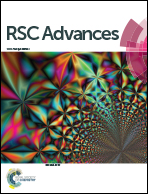One-step synthesis of boron nitride carbon nanosheets containing zinc oxide for catalysis of the oxygen reduction reaction and degradation of organic dyes†
Abstract
Boron nitride carbon nanosheets containing zinc oxide (ZnO/h-BNC) with a hexagonal B–N bond structure were prepared using a scalable, one-step process involving the thermal treatment of glycine, zinc nitrate, graphene oxide and boron oxide. The as-prepared ZnO/h-BNC hybrids were active for both the electrocatalytic reduction of oxygen under alkaline conditions and the photocatalytic oxidation of methyl orange dye. The ZnO/h-BNC nanosheets showed a much improved onset potential and reduced current density compared with ZnO/BCN sheets with a dominant C![[double bond, length as m-dash]](https://www.rsc.org/images/entities/char_e001.gif) N bond configuration for the oxygen reduction reaction (ORR). The BNC enriched with h-BN showed an excellent ORR performance, whereas the C
N bond configuration for the oxygen reduction reaction (ORR). The BNC enriched with h-BN showed an excellent ORR performance, whereas the C![[double bond, length as m-dash]](https://www.rsc.org/images/entities/char_e001.gif) N dominant BCN showed relatively less activity for the ORR, suggesting an intrinsic difference in properties of the BCN-based materials with different bond configurations. The Zn species located inside the h-BNC matrix acted as photocatalytically active centres for the degradation of methyl orange dye under UV irradiation.
N dominant BCN showed relatively less activity for the ORR, suggesting an intrinsic difference in properties of the BCN-based materials with different bond configurations. The Zn species located inside the h-BNC matrix acted as photocatalytically active centres for the degradation of methyl orange dye under UV irradiation.


 Please wait while we load your content...
Please wait while we load your content...